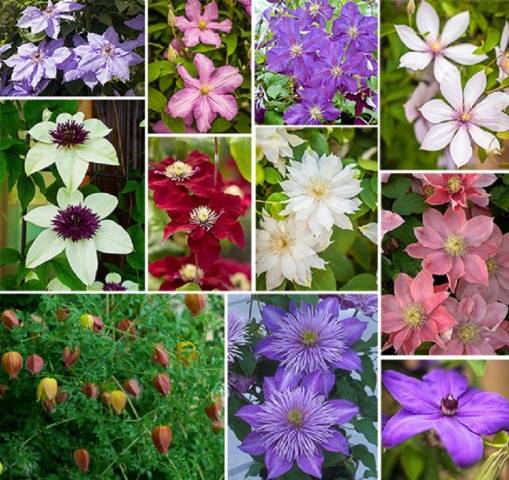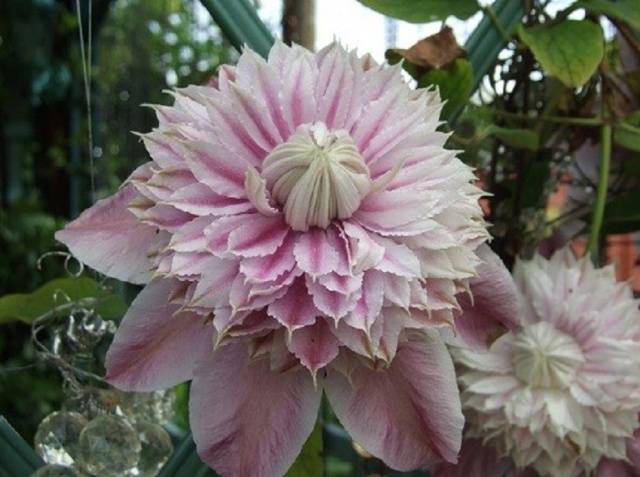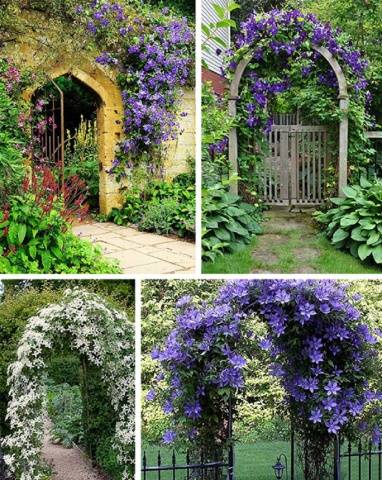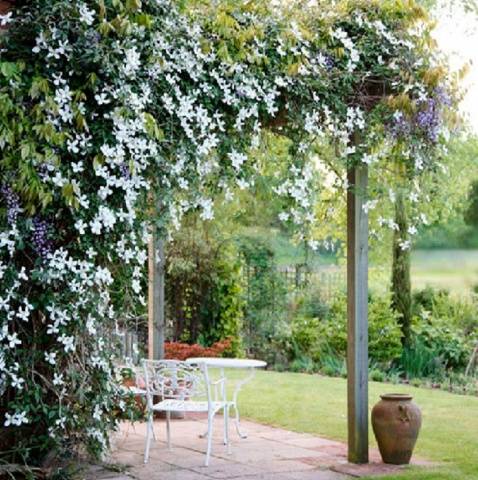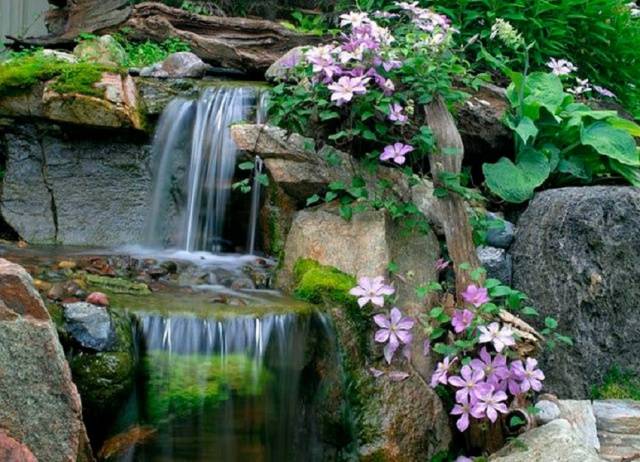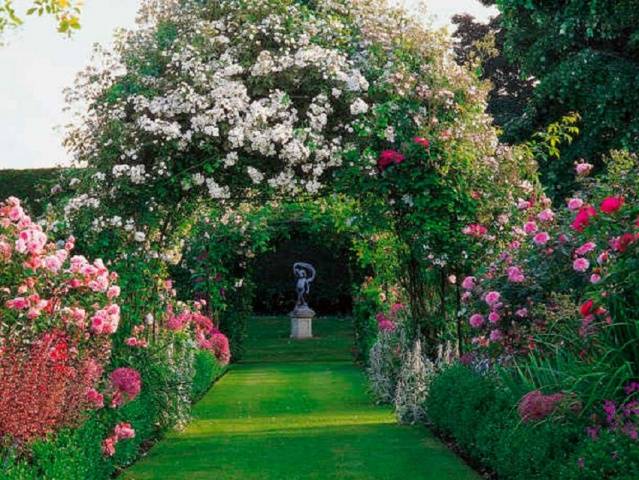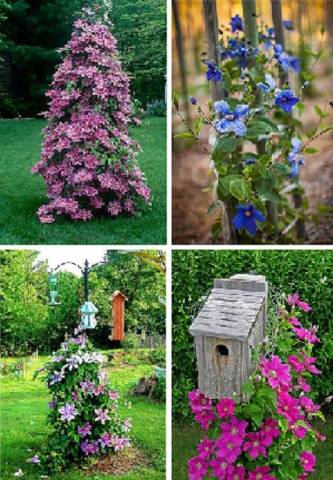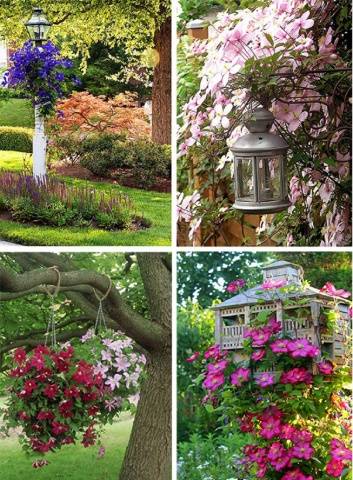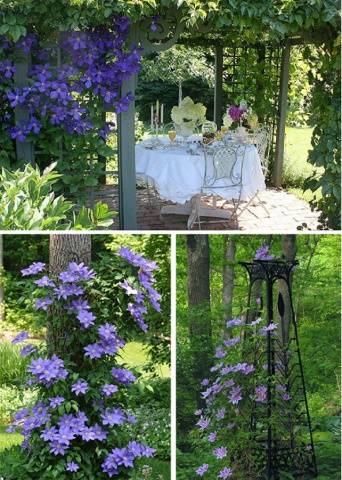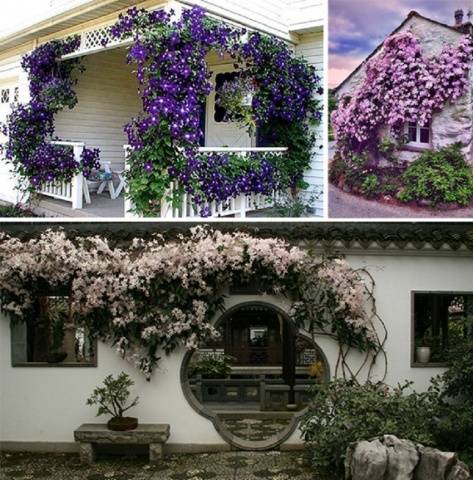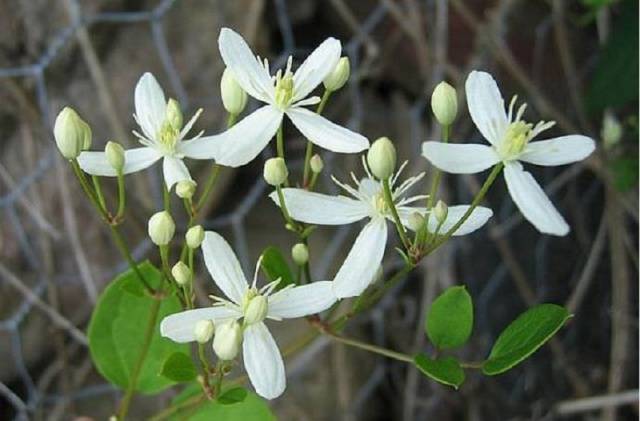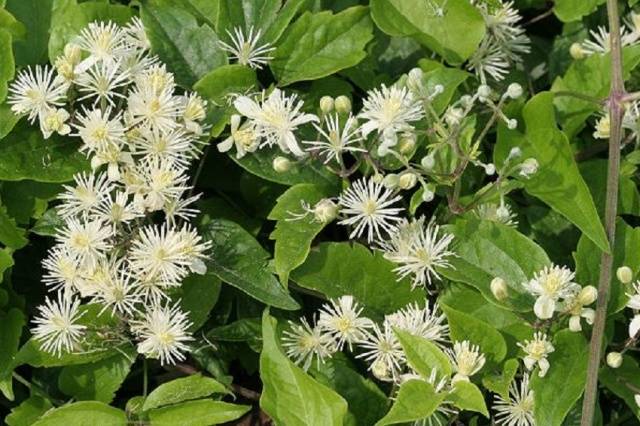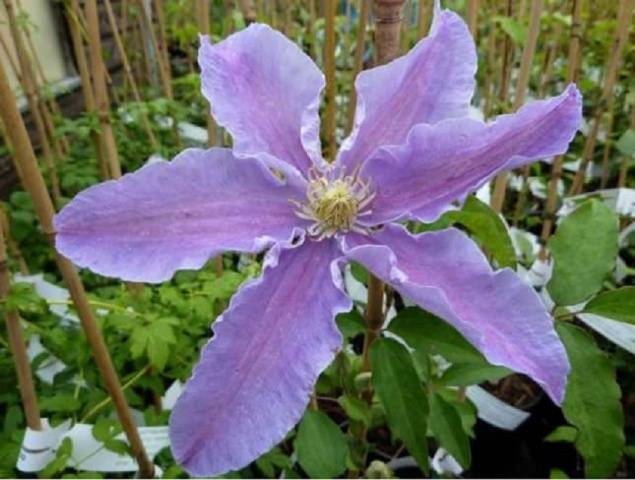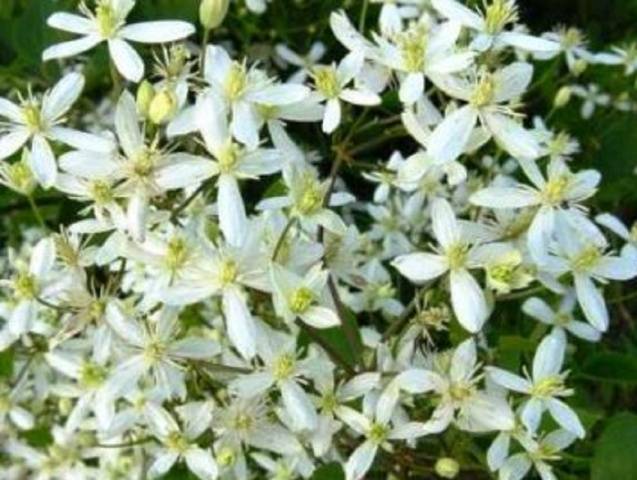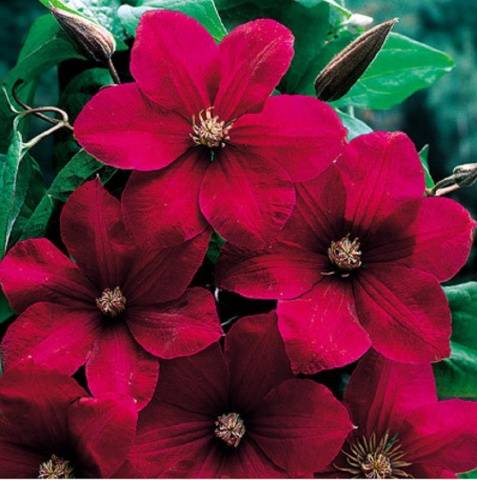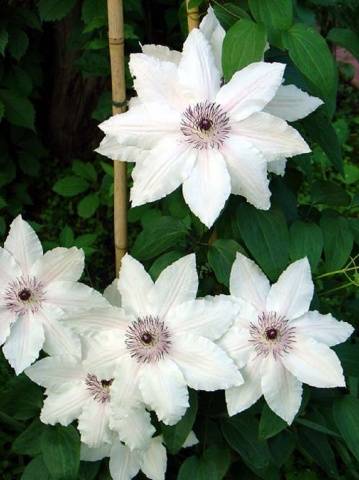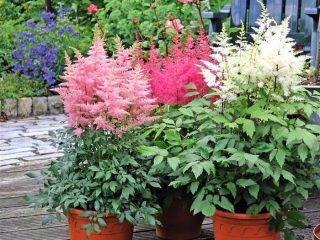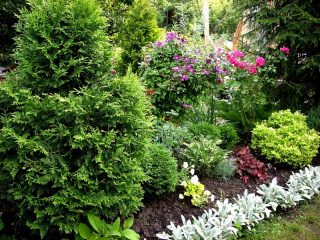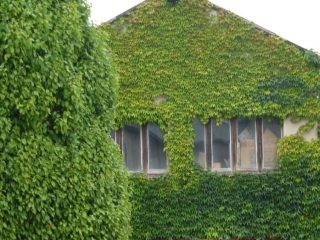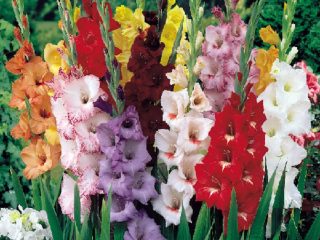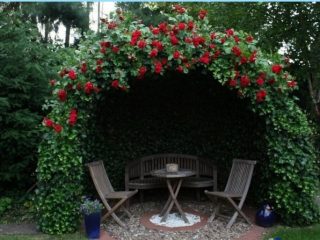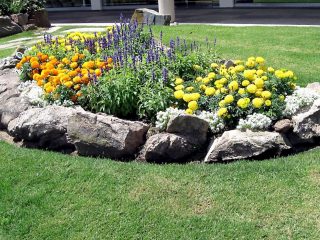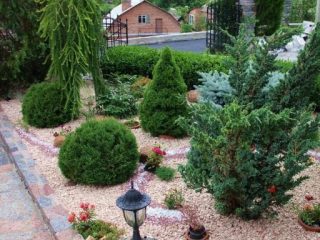Content
There is always a need for landscaping of vertical structures. The most popular plants for such vertical gardening are clematis (clematis).
Magnificent flowers look very impressive and allow you to plan various compositions in landscape design. Clematis in landscape design are used in various successful landscaping options. More than 300 plant species allow you to vary the color and vine-like structure of the stem. There are clematis with different flowering periods, so you can successfully combine them to decorate the area throughout the summer. Varieties differ in flower size and flowering period. Small-flowered ones bloom earlier, already in early May. The large-flowered ones bloom at the end of July, but continue to remain fresh until frost.
The plants belong to the garden vine family. Even novice landscape designers work with clematis, thanks to their ability to instantly diversify the color palette of a summer cottage. Mainly in landscape design, they use the property of clematis stems to attach to any nearby surface.Therefore, it is easy to cover any supports with the help of a perennial bushy vine. These include all kinds of arches, gates, railings.
Translated from Greek, “terminal” means vine. The plant curls around a support and retains its shape regardless of weather conditions.
But this is not the only purpose of clematis in landscape design of plots. With the same success, they amazingly decorate alpine slides or creative compositions that use a creeping carpet of luxurious vines. Designers have more than 2,000 plant varieties at their disposal, with which they can develop their creativity. Clematis produces many shoots, abundantly strewn with beautiful flowers. Up to 500 flowers can bloom on one plant at the same time. This flowering cape will take the shape you plan.
Ideas for decorating a site
You can choose a blooming “waterfall” for landscape design to suit every taste. Some people prefer to use clematis of the same tone and shape. An extraordinary solution would be a simultaneous combination of several types. Especially if they bloom at different times and are pleasing to the eye until autumn. Photos of options for how to use clematis in landscape design will make choosing a solution easier.
Clematis comes in four main types of forms:
- herbaceous perennials;
- vines;
- subshrubs;
- bushes.
Herbaceous varieties ideal for compositions of alpine slides or flower beds. They are left without support, and climbing clematis replaces ground cover in landscape design, but with more lush vegetation.
Subshrubs planted to frame paths or low arches. The peculiarity of this form of clematis is the woodiness of the lower part of the trunk, so the plant cannot rise to a great height.
Tall the shape will skillfully hide some objects that are difficult to remove - pillars, trees. They will serve as a support for the clematis and, at the same time, will be hidden under its lush flowers.
In some landscaping projects, the plant is placed near the trunk circle so that the stems weave around the tree trunk. A green crown interspersed with a flowering garland will look very impressive in a sunny meadow.
Clematis in landscape design perfectly serve as decoration for areas where lilacs and rose hips grow. They decorate the bushes after they bloom.
The most harmonious combination of clematis is demonstrated with climbing roses. You can create a whole garden in such a composition. The ideal duo in landscape design are vines with yellow or light varieties of roses.
Like many other plants, clematis are grown in pots and containers. This is very convenient in places with poor soil or no soil at all. The flowerpot must be equipped with drainage and do not forget to water the vine.
To create a weaving fence, any support or homemade frame will do. By letting the vine onto the chain-link mesh, you can place such a hedge in a convenient place. You should not try to completely weave the mesh. From afar, the flowers will appear to be floating in the air.
To make clematis bloom beautifully for a long time, some tricks will help.
To ensure that the surface of a hedge or garland is uniform, the shoots should be trimmed regularly and the bush should be shaped using guides. Their role can be played not only by supports or a fence, but also by wire and mesh. It is convenient to attach the wire with hooks to any wall in the desired direction to help the clematis weave the required space.
Small architectural forms and other ideas with clematis
This technique will create an attractive accent in the landscape design of the site. As a soloist, clematis is rightfully considered a leader. The plant does not require special conditions or a lot of space. The beauty is easy to create on a lamp post or birdhouse stand. These small highlights will greatly enliven the garden landscape.
The simplest solution would be to use clematis as an hanging plant in an open area. A flower arrangement with flowing garlands of luxurious inflorescences will decorate not only a garden tree, but also a terrace or window opening.
In addition, by correctly positioning the support, you can, together with the decor, keep yourself cool on a hot day. In the evening, clematis flowers emit an amazingly subtle aroma.
For decorating the front entrance, clematis has no equal in landscape design. The color can be matched to any building style. With the help of a vine you can emphasize your taste and charm your guests from the first minute. An important advantage of clematis in the entrance area is their long flowering period. Therefore, beauty will accompany you throughout the summer season until the cold weather.
Popular types of clematis
There are a great many varieties of garden vines. Let's try to dwell on some of them. All of them are pruned at the end of the season.
"Manchurian"
Bush form of clematis.It has a delicate aroma; in appearance the flower resembles a night violet (mathiola).
"Grape leaf"
An excellent option for thickets. A liana with large double flowers reaches 10 meters in height.
"Beata"
May have simple or semi-double flowers, but always large. The color of the petals is bluish-pinkish. Does not grow without support.
"Burning"
A great option for cool regions. Very resistant to low temperatures, does not lose its decorative effect throughout the season.
"Cardinal"
Hybrid winter-hardy variety. Suitable for growing on balconies or terraces in regions with low temperatures. It grows up to 2 meters in length, the flower is large up to 15 cm in diameter.
"Ballerina"
A find for beginners. Very easy to grow. It blooms profusely and for a long time, tolerates temperature changes well, and is resistant to diseases and pests.
Conclusion
Another plus of clematis for those who like consistency.
Therefore, try to choose a more stable place for clematis in the landscape design of the site. The plant demonstrates its full decorative potential in the third year after planting. The root system of a garden vine does not require a large area; it is compact. But the stems grow and need several square meters to accommodate them. This also needs to be taken into account when choosing a place for clematis in landscape design.
Clematis grow well on the southern, southwestern, and southeastern sides of the site. Plants are planted from each other at a distance of at least 1-1.5 meters. It is better to select a support for the vine with a small diameter - mesh, wire, twine.In this case, the clematis leaves curl around it and thus attach to the support. On a large support diameter this is not possible due to the short length of the leaf petiole.
Another advantage of beautiful clematis in landscape design is the lack of need for chemical treatments. Disease resistance allows plants to grow without these techniques. In any case, if you plant clematis on your site, you will not be disappointed. Long-term cooperation with beautiful vines will bring you a lot of pleasure.
